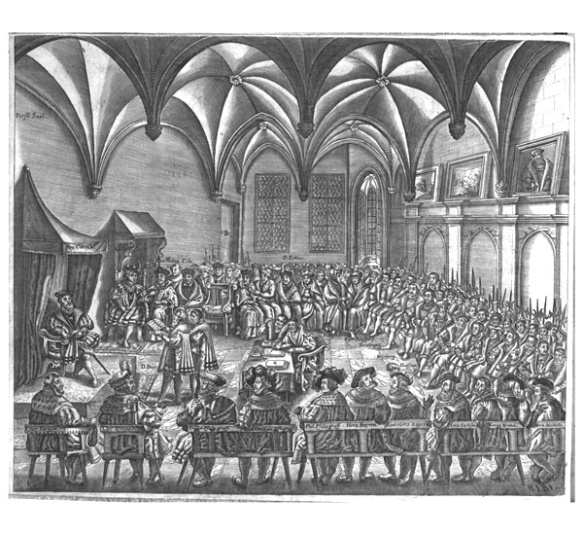Following the Convention of Passau (1552), Ferdinand I and Charles V agreed to a general settlement of the confessional and princely wars in Germany. What occasioned concession for Ferdinand was pragmatism; for Charles it was military defeat and personal melancholia, which also moved him to abdicate. Augsburg established a principle of religious truce, rather than peace, based on limited tolerance between Catholics (‘‘the old religion’’) and Lutherans (those ‘‘espousing the Augsburg Confession’’). The great principle of the Peace was: ‘‘cuius regio eius religio’’ (‘‘whosoever rules the territory decides the religion’’), although that famous summary phrase was not coined for many more years. The toleration afforded at Augsburg was importantly limited by the reservatum ecclesiaticum and freezing of the religious status quo in Imperial Cities, with only 8 out of 60 confessionally divided. Calvinists, Anabaptists, and other reformed faiths were explicitly excluded from the settlement (‘‘all such as do not belong to the two above named religions shall not be included in the present peace but be totally excluded from it’’). Nor did Augsburg toleration apply outside the confines of the Holy Roman Empire. Still, the Peace of Augsburg tempered the religious question in Germany for 50 years, until it broke down leading into the Thirty Years’ War (1618–1648). This was a major accomplishment in the very land that midwifed the Protestant Reformation, and where triconfessional zealotry burned perhaps most fiercely. No one thought that permanent peace would result from the agreement; few even desired such an outcome, since all sides regarded the Church as indivisible. It was understood by all that religious debate would continue, just as all were convinced that the obvious truth of their own position must surely prevail. Augsburg promised only a military peace, not civil or social tranquility. A cynic might say that it only delayed the violent resolution of confessional conflict until the next century, and then at the cost of perpetuating Germany’s fragmentation even as other powers around it were emerging as powerful ‘‘new monarchies.’’ An idealist would say that Augsburg presaged a future where medieval civil and religious authority gave way to rational secularism in politics, leading to broad tolerance of the disparate beliefs of individuals in civil and private affairs. A realist would say that it was an expedient, short-term pause in a ferocious conflict that had temporarily exhausted both sides, and that it was probably the most that could be achieved at the intersection of limited religious imagination and the hard confessional realities of the day.
Augsburg is all the more remarkable for the contrasting solutions essayed by other rulers in other states at that time. In Spain, Philip II refused a request from his Burgundian subjects to permit limited tolerance of individual conscience, then launched a crusade to repress traditional liberties in the Spanish Netherlands that provoked the Dutch to rebellion and led directly to the Eighty Years’ War (1568–1648). Philip also made war against Elizabethan England in the name of a Catholic policy while she sent Francis Drake to sack his ports and supported Spain’s Protestant enemies in the Netherlands. While Germany remained at peace, the French Civil Wars (1562–1629) tore that society apart, ravaging France for 30 years as Catholics and Calvinists (Huguenots) killed with abandon and kept France in a chronic state of weakness, civil war, and murderous strife. Given those choices and national tragedies, the German peace achieved at Augsburg must be judged a considerable success, even if by the 1570s confessionalism became more rigid and pronounced as all sides recognized a new reality of perpetual doctrinal warfare and a divided Church in fact. The most direct parallel to Augsburg was actually in the Islamic world, where the Treaty of Amasya, also signed in 1555, divided the territory of Muslims between hostile shi’ia and sunni states just as Augsburg divided German Christians. While both treaties offered respite, neither ultimately kept the peace.
